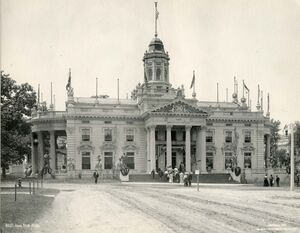Iowa: Difference between revisions
(Created page with "{{short description|Iowa State Building}} {{Infobox prepared food | name = Iowa State Building | image = Iowa State Building.jpg | image_size = 300px | caption = Iowa State Building | alternate_name = | country = | creator = | course = | cost = $43,995 ({{Inflation|US|43,995|1904|fmt=eq}}) | admission = | profit = | owner = | main_ingredient = | variations...") |
|||
| Line 35: | Line 35: | ||
Like many of the second floors of the States Buildings, there were rooms for conferences, suites of apartments for the Governor, the hostess and other dignitaries as well as a recital hall. | Like many of the second floors of the States Buildings, there were rooms for conferences, suites of apartments for the Governor, the hostess and other dignitaries as well as a recital hall. | ||
==After the Fair== | ==After the Fair== | ||
After the fair, the building was reportedly relocated to Iowa as asylum for treatment of alcoholics. | |||
==See also== | ==See also== | ||
Revision as of 06:43, 9 November 2022
 Iowa State Building | |
| Construction Cost | $43,995 (equivalent to $1,326,857 in 2021) |
|---|---|
Iowa's State building was the first State structure to be constructed on the Plateau of States. The 102 by 148 foot structure combined the old and new features of the Iowa City and Des Moines capital buildings.
Etymology
Before the Fair
Description
Each end of the building was a semi-circular colonnade two stories high; promenades surrounded the building at the ground level and the second story level 55 feet from the ground. Across the front were superb bronze figures of Sherman, Henderson, Farragut, and Dodge.
The interior showcased a great pipe organ given as a gift by ex-Governor Larrabee. Other room highlighted gambling paraphernalia such as dice, inlaid cards, etc.
The main floor consisted of a had a recital hall in the center, and a reception room.
Like many of the second floors of the States Buildings, there were rooms for conferences, suites of apartments for the Governor, the hostess and other dignitaries as well as a recital hall.
After the Fair
After the fair, the building was reportedly relocated to Iowa as asylum for treatment of alcoholics.
